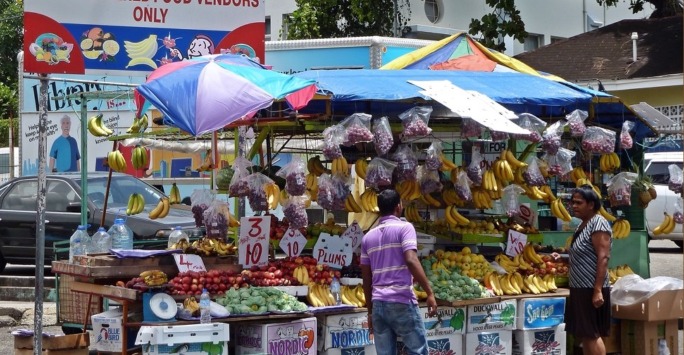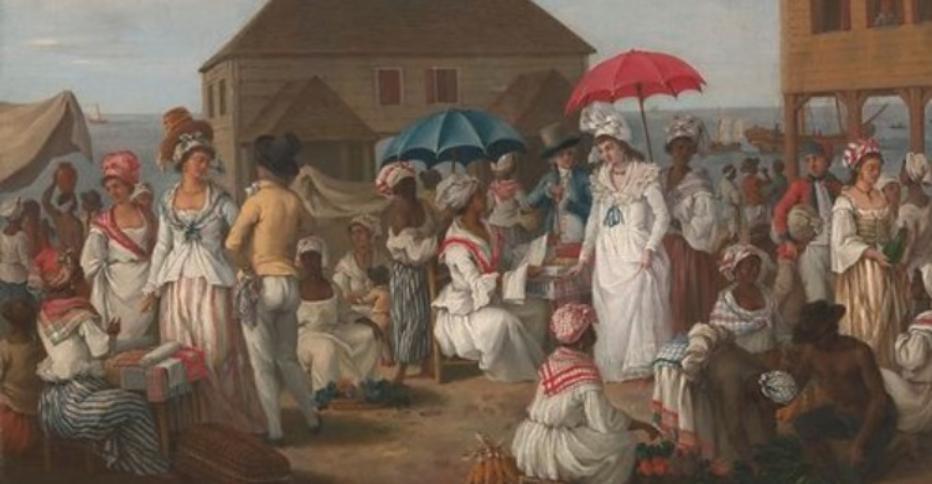Come Wi Guh down Fi Guh Buy Banana’: Transatlantic Slavery and Caribbean Farmers’ Markets

The Caribbean is a popular tourist destination known for its colourful carnivals and tropical beaches, but rarely do visitors venture outside of tourist hot spots. In doing so, they miss the rich cultural atmosphere of the wider parishes and its many farmers' markets.
I have fond memories of the markets in Clarendon, Jamaica, eating mango while my grandmother haggles with the vendors or catches up with her friends on the stands. I encourage you to observe the image of the street vendors of San Fernando, in Trinidad and Tobago above and visualise yourself within its atmosphere; the row of fresh fruits and vegetables, the aromatics of cooked food, the layered voices of vendors, underpinned by the thumping bass of music in the background. Farmers' markets are the core of the Caribbean- the socio-economic and cultural hub on which locals heavily depend. Its significance, however, runs deeper than the contemporary, with its roots tied to the transatlantic slave trade.
The British Caribbean sought the capture migration and commodification of around 2.3 million African peoples. Forced to endure back-breaking free labour, violence and sexual terror, the working lives of enslaved peoples were ones of misery and despair. Coerced to work during the week, enslaved peoples were however granted days off on Christian holidays such as Christmas and Easter, and Sundays. While these days were not permitted across all islands and plantations, they would utilise these days off to recover from the rest of the week, tend to their home duties, and visit the Sunday markets. Sunday markets were a popular hub of social, economic, and cultural development visited by people from both urban and rural areas. According to Jamaican enslaver Bryan Edwards, “10,000 people gathered every Sunday in the market of Kingston.”
To generate profit, enslaved peoples would keep rationed food such as guinea corn, yams, and rice from their enslavers to sell at these markets. Additionally, they would use the plots of land allotted by enslavers to tend to livestock and grow produce to be sold. The Sunday markets were greatly gendered, with enslaved women dominating the marketplace. In islands such as Saint-Domingue, men maintained the grounds while enslaved women went to market. On islands such as Barbados and Antigua however, women both maintained the provision grounds while ensuring that their produce was transported and sold. The gendered nature of these markets continues to the present with current stalls being run by women, who remain a central feature of the agricultural economy and value chain.
Sunday markets, for many, represented a source of income which contributed to improving the quality of enslaved people’s lives. Some enslaved women in Antigua, for example, acquired jewellery and expensive muslins and madras handkerchiefs from their income, which they would then wear and show off at the market. On rare occasions, enslaved people could save up and buy their manumission, enabling them to possess and own property. Most notably, selling produce at these Sunday markets provided enslaved peoples with revenue in which they could vary their nutrition producing a more balanced and nutritious diet than the guinea corn and yam provided by planters.
Not only did these markets provide an increased level of financial freedom, but they also became centres for enslaved persons to transgress the social and geographic boundaries imposed by plantations. The market was a meeting place for enslaved and free people of colour to interact, producing a sense of community and shared identity; unsurprisingly, revolts were occasionally organised and enacted within these spaces. The Sunday markets also encouraged an amalgamation of cultures. Enslaved women, most notably, would often sell lacebark of the Lagetta lagetto tree as a material for dresses, often reflecting a Creole style. It was also within these markets and the affairs that followed that musical expression were prominent. Dancing was an exemplary post-market activity, with dance moves, instruments and accompanying music being distinctly ‘African’ in nature. Enslaved peoples combined various African and European cultures, carving a new creolised identity. This celebration of cultures displayed through the Sunday markets is a dominant legacy exhibited within markets today through the styles of clothing sold and most notably, Caribbean music. Folk songs such as Solas Market and Linstead Market, for example, are dedicated to the atmosphere of these markets and their relation to the livelihoods of Caribbean people.

The liberties and cultural expression these markets gave to enslaved peoples, however, did not come without its opposition. While they allowed for a greater level of autonomy for enslaved people, they remained within and were constantly reminded of, the hegemonic structures of the slave trade. In Barbados, ‘the cage’, a temporary prison to capture runaway slaves, stood in the middle of Bridgetown amongst the markets, reproducing colonial power and reinforcing social and racial hierarchies. In addition, many provisions and laws were enacted to restrict the movement and entrepreneurship of enslaved peoples. The 1749 law in Barbados, for example, made it illegal for slaves to assemble at huckster shops for any reason, and the 1831 law in Antigua saw the outlaw of Sunday markets in its entirety.
Despite these laws, brutal treatments and the oppression of slavery looming over them, resistance and revolt remained at the heart of the markets. Enslaved people continued to defy these laws and their enslavement through numerous avenues. While many simply ignored them and continued to partake in the marketing system, others fought back with violence. In response to the 1831 Antiguan laws, for example, twenty-three estates were burned down and martial law was declared, which remained for three weeks; as a result, the markets were reinstated and moved to Saturday in 1832. The cultures expressed within these markets were a quintessential act of resistance. In maintaining African elements of culture within dance, dress and carving their path of creolised identity, enslaved peoples defied hegemonic European norms. The farmers' markets that persist today are representative of this defiance and remain a symbol of cultural identity and ancestral strength.
Farmers' markets remain an economic staple in the Caribbean. However, climate change and the cost of living crisis continue to put these markets at risk. This has resulted in a great impairment of the incomes and livelihoods of local Caribbean peoples. Torrential rain and flooding have dominated areas such as Barbados and Trinidad and Tobago causing a harmful shortage of crops and produce for local farmers, with droughts producing the same result in Jamaica. The shortage of crops and fertilisers has been exacerbated by the COVID-19 pandemic and the recent outbreak of the Russia-Ukraine war in 2022, triggering another rise in inflation around the Caribbean. According to international economist Dr Justin Ran in 2020, “ the Caribbean will become the poorest region in the world by 2050,” with the decline of the farmers' markets playing a noticeable role. Great action has been taken to tackle the economic decline of Caribbean countries. St Lucia Sectoral Adaption Strategy for the Agricultural Sector, for instance, has outlined goals to promote climate-resilient crop and livestock production from 2018-2028. The Caribbean Farmers Without Borders was formed in 2020 to encourage the improvement of business management for farmers and expand the agricultural trade in Caribbean regions internationally.
Farmers' markets and agricultural production are the foundation of the Caribbean economy. Quite literally they are museums of cultural expression, a community archive of society and identity. Its importance spans way beyond the contemporary, standing as a symbol of culture, resistance, and historical entrepreneurship. The environmental and political climate, therefore, not only puts these markets at risk but affects the heavy history it carries.
Interestingly, with the Caribbean being a tourism-dependent region, the Inter-American Institution for Cooperation on Agriculture suggests that the Caribbean should be positioned as a world-class Food Tourism destination. It urges local chefs and professionals to use and promote the produce grown by farmers to ensure food security for both locals and tourists. As a result, tourism would play a crucial part not just in Caribbean economic growth as a whole but in the restoration and survival of these markets. So if you ever get the privilege to visit one of these beautiful islands, I urge you to venture outside of the island resorts and visit the farmers’ markets. Experience these cultures, bask in their rich history and most importantly, invest in these vendors to ensure their longevity.
Written by Taylar Charles